
List of heads of state of Spain
Encyclopedia
This is a list of Spanish Heads of State
; that is, kings and Presidents that ruled on the country of Spain in the modern sense of the word. The forerunners of the Spanish throne, as well as of the Portuguese throne, were the following:
These lineages were eventually united by the marriage of Ferdinand II of Aragon
and Isabella I of Castile
. Although their kingdoms continued to be separate, with their personal union
they ruled them together as one dominion. Ferdinand also conquered the southern part of Navarre
and annexed it to what was to become Spain. Isabella left her kingdom to her daughter Joanna of Castile
. Ferdinand served as her regent during her insanity
; though rebuffed by the Castilian nobility and replaced by Joanna's husband Philip the Handsome, he resumed his regency after Philip's death. In 1516, after Ferdinand II's death, his daughter Joanna inherited the kingdom of Aragon, but was kept prisoner at Tordesillas as insane. As Joanna's son, the future Holy Roman Emperor
Charles V, did not want to be merely a regent, he was proclaimed king of Castile and Aragon jointly with his mother in Brussels. Subsequently, Castilian and Aragonese Cortes alleged oath to him as co-king with his mother. Upon her death, he became sole King of Castile and Aragon, and the thrones were thereafter united permanently.
During the First Spanish Republic
(1873–74), Spain had heads of state known as the President of the Executive Power.
It is only during the Second Spanish Republic
(1931–39), however, that the official title of President of Spain (or President of the Republic) existed.
Today, Spain is a constitutional monarchy
, and there is thus no person holding the title of President
of Spain. However, the Prime Minister
holds the official title of President of the Government.
House of Bourbon
In the year 1700 Charles II died. Charles' will named the 16-year old Philip, the grandson of Charles' sister Maria Theresa of Spain
, as his successor. Upon any possible refusal the Crown of Spain would be offered next to Philip's younger brother Charles, duc de Berry, or, next, to Archduke Charles of Austria
.
Both claimants, Philip and Charles, had a legal right to the Spanish throne due to the fact that Philip's grandfather, King Louis XIV of France
and Charles's father, Leopold I, Holy Roman Emperor
, were sons of Charles' aunts, Anne of Austria
and Maria Anna of Austria. Philip had the better claim because his grandmother
and great-grandmother
were older than Leopold's. However, the Austrian branch claimed that Philip's grandmother had renounced the Spanish throne for herself and her descendants as part of her marriage contract. This was countered by the French branch's claim that it was on the basis of a dowry that had never been paid.
After a long council meeting where the Dauphin spoke up in favour of his son's rights, it was agreed that Philip would ascend the throne but would forever renounce his claim to the throne of France for himself and his descendants. Thus, the war broke out and Archduke Charles
was proclaimed king of Spain, as Charles III opposite to Philip V.
, imposed by his brother Napoleon I of France
after the kings Charles IV and Ferdinand VII abdicated. The title used by Joseph was King of the Spains and the Indias, by divine grace and the Constitution of the State . He was also later given all of the titles of the previous kings.
House of Bourbon
Charles IV's eldest son was restored to the throne. Again the title used was king of Castile, Leon, Aragon,… by divine grace.
House of Savoy
After the Spanish Revolution of 1868
deposed Isabella II, there was established a provisional government and a regency headed by Francisco Serrano y Domínguez, who acted as Head of State, from October 8, 1868 until December 4, 1870 while it was requested a new monarch. Amadeo I was elected as king and the new title used was King of Spain, by divine grace and will of nation.
First Spanish Republic
The First Spanish Republic started with the abdication
as King of Spain on February 10, 1873 of Amadeo I, following the Hidalgo Affair, when he had been required by the radical government to sign a decree against the artillery officers. The next day, February 11, the republic was declared by a parliamentary majority made up of radicals, republicans and democrats. It lasted twenty-three months
House of Bourbon
Isabella II's eldest son was restored to the throne. Constitutional king of Spain. Between the death of Alfonso XII and the birth of Alfonso XIII, there was an interregnum
of seven months where Queen Maria Christina
served as Head of State with the title of Regent.
Second Spanish Republic
The Second Spanish Republic was the system of government in Spain between April 14, 1931 when King Alfonso XIII
left the country following a period of social unrest after the collapse of General Primo de Rivera
's dictatorship a year earlier, and April 1, 1939 when the last of the Republican (republicanos) forces surrendered to Nationalist (nacionales) forces led by Francisco Franco
, at the end of the Spanish Civil War
.
was proclaimed Head of State (Caudillo) in parts of Spain controlled by Nationalist (nacionales) forces after Spanish Civil War
broke out. After the end of war on April 1, 1939 General Franco took control of entire Spain. In 1947, Franco proclaimed the restoration of the monarchy, but did not allow the pretender, Juan de Borbón, Count of Barcelona, to take the throne. In 1969, Franco declared that Juan Carlos, the Count of Barcelona's son, would be his successor. After Franco's death in 1975, Juan Carlos succeeded him as the King of Spain.
House of Bourbon
Alfonso XIII's claim descended (due to his two eldest sons' renunciations) to his third son, Infante Juan, Count of Barcelona, who was passed over in favour of his eldest son, whose title is King of Spain. The Count of Barcelona renounced his claims in favour of his son in 1977, two years after Franco's death and Juan Carlos's accession.
Head of State
A head of state is the individual that serves as the chief public representative of a monarchy, republic, federation, commonwealth or other kind of state. His or her role generally includes legitimizing the state and exercising the political powers, functions, and duties granted to the head of...
; that is, kings and Presidents that ruled on the country of Spain in the modern sense of the word. The forerunners of the Spanish throne, as well as of the Portuguese throne, were the following:
- Kings of the Visigoths
- Kings of Aragon
- Kings of Asturias
- Kings of Castile
- Kings of Galicia
- Kings of Leon
- Kings of Navarre
These lineages were eventually united by the marriage of Ferdinand II of Aragon
Ferdinand II of Aragon
Ferdinand the Catholic was King of Aragon , Sicily , Naples , Valencia, Sardinia, and Navarre, Count of Barcelona, jure uxoris King of Castile and then regent of that country also from 1508 to his death, in the name of...
and Isabella I of Castile
Isabella I of Castile
Isabella I was Queen of Castile and León. She and her husband Ferdinand II of Aragon brought stability to both kingdoms that became the basis for the unification of Spain. Later the two laid the foundations for the political unification of Spain under their grandson, Charles V, Holy Roman Emperor...
. Although their kingdoms continued to be separate, with their personal union
Personal union
A personal union is the combination by which two or more different states have the same monarch while their boundaries, their laws and their interests remain distinct. It should not be confused with a federation which is internationally considered a single state...
they ruled them together as one dominion. Ferdinand also conquered the southern part of Navarre
Navarre
Navarre , officially the Chartered Community of Navarre is an autonomous community in northern Spain, bordering the Basque Country, La Rioja, and Aragon in Spain and Aquitaine in France...
and annexed it to what was to become Spain. Isabella left her kingdom to her daughter Joanna of Castile
Joanna of Castile
Joanna , nicknamed Joanna the Mad , was the first queen regnant to reign over both the Crown of Castile and the Crown of Aragon , a union which evolved into modern Spain...
. Ferdinand served as her regent during her insanity
Insanity
Insanity, craziness or madness is a spectrum of behaviors characterized by certain abnormal mental or behavioral patterns. Insanity may manifest as violations of societal norms, including becoming a danger to themselves and others, though not all such acts are considered insanity...
; though rebuffed by the Castilian nobility and replaced by Joanna's husband Philip the Handsome, he resumed his regency after Philip's death. In 1516, after Ferdinand II's death, his daughter Joanna inherited the kingdom of Aragon, but was kept prisoner at Tordesillas as insane. As Joanna's son, the future Holy Roman Emperor
Holy Roman Emperor
The Holy Roman Emperor is a term used by historians to denote a medieval ruler who, as German King, had also received the title of "Emperor of the Romans" from the Pope...
Charles V, did not want to be merely a regent, he was proclaimed king of Castile and Aragon jointly with his mother in Brussels. Subsequently, Castilian and Aragonese Cortes alleged oath to him as co-king with his mother. Upon her death, he became sole King of Castile and Aragon, and the thrones were thereafter united permanently.
During the First Spanish Republic
First Spanish Republic
The First Spanish Republic was the political regime that existed in Spain between the parliamentary proclamation on 11 February 1873 and 29 December 1874 when General Arsenio Martínez-Campos's pronunciamento marked the beginning of the Bourbon Restoration in Spain...
(1873–74), Spain had heads of state known as the President of the Executive Power.
It is only during the Second Spanish Republic
Second Spanish Republic
The Second Spanish Republic was the government of Spain between April 14 1931, and its destruction by a military rebellion, led by General Francisco Franco....
(1931–39), however, that the official title of President of Spain (or President of the Republic) existed.
Today, Spain is a constitutional monarchy
Constitutional monarchy
Constitutional monarchy is a form of government in which a monarch acts as head of state within the parameters of a constitution, whether it be a written, uncodified or blended constitution...
, and there is thus no person holding the title of President
President
A president is a leader of an organization, company, trade union, university, or country.Etymologically, a president is one who presides, who sits in leadership...
of Spain. However, the Prime Minister
Prime Minister of Spain
The President of the Government of Spain , sometimes known in English as the Prime Minister of Spain, is the head of Government of Spain. The current office is established under the Constitution of 1978...
holds the official title of President of the Government.
House of Habsburg
Under Charles I, the two thrones of Castile and Aragon were finally united under one monarch.| # | Picture | Coat of arms Coat of arms of Spain The current coat of arms of Spain, although it has its roots centuries ago, was approved by law in 1981, when the present established replaced the interim version which, in turn, replaced the official arms of Francoist Spain... |
Name | Spanish Name | Monarch From | Monarch Until | Titles Used | Relationship with predecessor(s) |
|---|---|---|---|---|---|---|---|---|
| 1 | Charles I Charles V, Holy Roman Emperor Charles V was ruler of the Holy Roman Empire from 1519 and, as Charles I, of the Spanish Empire from 1516 until his voluntary retirement and abdication in favor of his younger brother Ferdinand I and his son Philip II in 1556.As... with Joanna Joanna of Castile Joanna , nicknamed Joanna the Mad , was the first queen regnant to reign over both the Crown of Castile and the Crown of Aragon , a union which evolved into modern Spain... (1516–1555) |
Carlos I | March 14, 1516 | January 16, 1556 | Holy Roman Emperor, King of the Romans, Italy and Spain, Archduke of Austria, (Titular) Duke of Burgundy, |
son and co-monarch of Joanna Joanna of Castile Joanna , nicknamed Joanna the Mad , was the first queen regnant to reign over both the Crown of Castile and the Crown of Aragon , a union which evolved into modern Spain... ; grandson of Isabella I Isabella I of Castile Isabella I was Queen of Castile and León. She and her husband Ferdinand II of Aragon brought stability to both kingdoms that became the basis for the unification of Spain. Later the two laid the foundations for the political unification of Spain under their grandson, Charles V, Holy Roman Emperor... and Ferdinand II Ferdinand II of Aragon Ferdinand the Catholic was King of Aragon , Sicily , Naples , Valencia, Sardinia, and Navarre, Count of Barcelona, jure uxoris King of Castile and then regent of that country also from 1508 to his death, in the name of... |
||
| 2 | Philip II Philip II of Spain Philip II was King of Spain, Portugal, Naples, Sicily, and, while married to Mary I, King of England and Ireland. He was lord of the Seventeen Provinces from 1556 until 1581, holding various titles for the individual territories such as duke or count.... |
Felipe II | January 16, 1556 | September 13, 1598 | King of Spain, Portugal, and Naples King consort of England and Ireland; Ruler of the Spanish Netherlands; Duke of Milan |
son of Charles I Charles V, Holy Roman Emperor Charles V was ruler of the Holy Roman Empire from 1519 and, as Charles I, of the Spanish Empire from 1516 until his voluntary retirement and abdication in favor of his younger brother Ferdinand I and his son Philip II in 1556.As... |
||
| 3 | 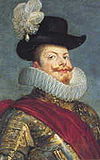 |
Philip III Philip III of Spain Philip III , also known as Philip the Pious, was the King of Spain and King of Portugal and the Algarves, where he ruled as Philip II , from 1598 until his death... |
Felipe III | September 13, 1598 | March 31, 1621 | King of Spain and Portugal | son of Philip II Philip II of Spain Philip II was King of Spain, Portugal, Naples, Sicily, and, while married to Mary I, King of England and Ireland. He was lord of the Seventeen Provinces from 1556 until 1581, holding various titles for the individual territories such as duke or count.... |
|
| 4 | 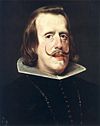 |
Philip IV Philip IV of Spain Philip IV was King of Spain between 1621 and 1665, sovereign of the Spanish Netherlands, and King of Portugal until 1640... |
Felipe IV | March 31, 1621 | September 17, 1665 | King of Spain and Portugal (until 1640) | son of Philip III Philip III of Spain Philip III , also known as Philip the Pious, was the King of Spain and King of Portugal and the Algarves, where he ruled as Philip II , from 1598 until his death... |
|
| 5 | .jpg) |
Charles II Charles II of Spain Charles II was the last Habsburg King of Spain and the ruler of large parts of Italy, the Spanish territories in the Southern Low Countries, and Spain's overseas Empire, stretching from the Americas to the Spanish East Indies... |
Carlos II | September 17, 1665 | November 1, 1700 | King of Spain Ruler of the Spanish Netherlands |
son of Philip IV Philip IV of Spain Philip IV was King of Spain between 1621 and 1665, sovereign of the Spanish Netherlands, and King of Portugal until 1640... |
|
House of BourbonHouse of BourbonThe House of Bourbon is a European royal house, a branch of the Capetian dynasty . Bourbon kings first ruled Navarre and France in the 16th century. By the 18th century, members of the Bourbon dynasty also held thrones in Spain, Naples, Sicily, and Parma...
In the year 1700 Charles II died. Charles' will named the 16-year old Philip, the grandson of Charles' sister Maria Theresa of SpainMaria Theresa of Spain
Maria Theresa of Austria was the daughter of Philip IV, King of Spain and Elizabeth of France. Maria Theresa was Queen of France as wife of King Louis XIV and mother of the Grand Dauphin, an ancestor of the last four Bourbon kings of France.-Early life:Born as Infanta María Teresa of Spain at the...
, as his successor. Upon any possible refusal the Crown of Spain would be offered next to Philip's younger brother Charles, duc de Berry, or, next, to Archduke Charles of Austria
Charles VI, Holy Roman Emperor
Charles VI was the penultimate Habsburg sovereign of the Habsburg Empire. He succeeded his elder brother, Joseph I, as Holy Roman Emperor, King of Bohemia , Hungary and Croatia , Archduke of Austria, etc., in 1711...
.
Both claimants, Philip and Charles, had a legal right to the Spanish throne due to the fact that Philip's grandfather, King Louis XIV of France
Louis XIV of France
Louis XIV , known as Louis the Great or the Sun King , was a Bourbon monarch who ruled as King of France and Navarre. His reign, from 1643 to his death in 1715, began at the age of four and lasted seventy-two years, three months, and eighteen days...
and Charles's father, Leopold I, Holy Roman Emperor
Leopold I, Holy Roman Emperor
| style="float:right;" | Leopold I was a Holy Roman Emperor, King of Hungary and King of Bohemia. A member of the Habsburg family, he was the second son of Emperor Ferdinand III and his first wife, Maria Anna of Spain. His maternal grandparents were Philip III of Spain and Margaret of Austria...
, were sons of Charles' aunts, Anne of Austria
Anne of Austria
Anne of Austria was Queen consort of France and Navarre, regent for her son, Louis XIV of France, and a Spanish Infanta by birth...
and Maria Anna of Austria. Philip had the better claim because his grandmother
Maria Theresa of Spain
Maria Theresa of Austria was the daughter of Philip IV, King of Spain and Elizabeth of France. Maria Theresa was Queen of France as wife of King Louis XIV and mother of the Grand Dauphin, an ancestor of the last four Bourbon kings of France.-Early life:Born as Infanta María Teresa of Spain at the...
and great-grandmother
Anne of Austria
Anne of Austria was Queen consort of France and Navarre, regent for her son, Louis XIV of France, and a Spanish Infanta by birth...
were older than Leopold's. However, the Austrian branch claimed that Philip's grandmother had renounced the Spanish throne for herself and her descendants as part of her marriage contract. This was countered by the French branch's claim that it was on the basis of a dowry that had never been paid.
After a long council meeting where the Dauphin spoke up in favour of his son's rights, it was agreed that Philip would ascend the throne but would forever renounce his claim to the throne of France for himself and his descendants. Thus, the war broke out and Archduke Charles
Charles VI, Holy Roman Emperor
Charles VI was the penultimate Habsburg sovereign of the Habsburg Empire. He succeeded his elder brother, Joseph I, as Holy Roman Emperor, King of Bohemia , Hungary and Croatia , Archduke of Austria, etc., in 1711...
was proclaimed king of Spain, as Charles III opposite to Philip V.
| # | Picture | Coat of arms | Name | Spanish Name | Monarch From | Monarch Until | Titles Used | Relationship with predecessor(s) |
|---|---|---|---|---|---|---|---|---|
| 6 | 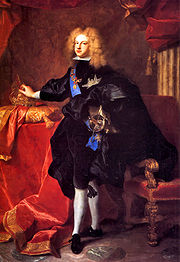 |
Philip V Philip V of Spain Philip V was King of Spain from 15 November 1700 to 15 January 1724, when he abdicated in favor of his son Louis, and from 6 September 1724, when he assumed the throne again upon his son's death, to his death.Before his reign, Philip occupied an exalted place in the royal family of France as a... |
Felipe V | November 16, 1700 | January 14, 1724 | King of Spain | Great Grandson of Philip IV Philip IV of Spain Philip IV was King of Spain between 1621 and 1665, sovereign of the Spanish Netherlands, and King of Portugal until 1640... , via his eldest (surviving) daughter, Maria Theresa of Spain Maria Theresa of Spain Maria Theresa of Austria was the daughter of Philip IV, King of Spain and Elizabeth of France. Maria Theresa was Queen of France as wife of King Louis XIV and mother of the Grand Dauphin, an ancestor of the last four Bourbon kings of France.-Early life:Born as Infanta María Teresa of Spain at the... |
|
| 7 | 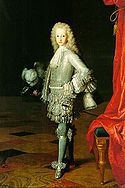 |
Louis I | Luis I | January 14, 1724 | August 31, 1724 | King of Spain | Son of Philip V Philip V of Spain Philip V was King of Spain from 15 November 1700 to 15 January 1724, when he abdicated in favor of his son Louis, and from 6 September 1724, when he assumed the throne again upon his son's death, to his death.Before his reign, Philip occupied an exalted place in the royal family of France as a... |
|
| 8 |  |
Philip V Philip V of Spain Philip V was King of Spain from 15 November 1700 to 15 January 1724, when he abdicated in favor of his son Louis, and from 6 September 1724, when he assumed the throne again upon his son's death, to his death.Before his reign, Philip occupied an exalted place in the royal family of France as a... |
Felipe V | September 6, 1724 | July 9, 1746 | King of Spain | Father of Louis I | |
| 9 | 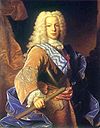 |
Ferdinand VI | Fernando VI | July 9, 1746 | August 10, 1759 | King of Spain | Son of Philip V Philip V of Spain Philip V was King of Spain from 15 November 1700 to 15 January 1724, when he abdicated in favor of his son Louis, and from 6 September 1724, when he assumed the throne again upon his son's death, to his death.Before his reign, Philip occupied an exalted place in the royal family of France as a... |
|
| 10 | 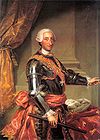 |
Charles III Charles III of Spain Charles III was the King of Spain and the Spanish Indies from 1759 to 1788. He was the eldest son of Philip V of Spain and his second wife, the Princess Elisabeth Farnese... |
Carlos III | August 10, 1759 | December 14, 1788 | King of Spain | Son of Philip V Philip V of Spain Philip V was King of Spain from 15 November 1700 to 15 January 1724, when he abdicated in favor of his son Louis, and from 6 September 1724, when he assumed the throne again upon his son's death, to his death.Before his reign, Philip occupied an exalted place in the royal family of France as a... |
|
| 11 |  |
Charles IV Charles IV of Spain Charles IV was King of Spain from 14 December 1788 until his abdication on 19 March 1808.-Early life:... |
Carlos IV | December 14, 1788 | March 19, 1808 | King of Spain | Son of Charles III Charles III of Spain Charles III was the King of Spain and the Spanish Indies from 1759 to 1788. He was the eldest son of Philip V of Spain and his second wife, the Princess Elisabeth Farnese... |
|
| 12 |  |
Ferdinand VII | Fernando VII | March 19, 1808 | May 6, 1808 | King of Spain | Son of Charles IV Charles IV of Spain Charles IV was King of Spain from 14 December 1788 until his abdication on 19 March 1808.-Early life:... |
|
House of Bonaparte
The only monarch from this dynasty was Joseph IJoseph Bonaparte
Joseph-Napoléon Bonaparte was the elder brother of Napoleon Bonaparte, who made him King of Naples and Sicily , and later King of Spain...
, imposed by his brother Napoleon I of France
Napoleon I of France
Napoleon Bonaparte was a French military and political leader during the latter stages of the French Revolution.As Napoleon I, he was Emperor of the French from 1804 to 1815...
after the kings Charles IV and Ferdinand VII abdicated. The title used by Joseph was King of the Spains and the Indias, by divine grace and the Constitution of the State . He was also later given all of the titles of the previous kings.
| # | Picture | Coat of arms | Name | Spanish Name | Monarch From | Monarch Until | Titles used | Relationship with predecessor(s) |
|---|---|---|---|---|---|---|---|---|
| 13 |  |
Joseph I Joseph Bonaparte Joseph-Napoléon Bonaparte was the elder brother of Napoleon Bonaparte, who made him King of Naples and Sicily , and later King of Spain... |
José I | June 6, 1808 | December 11, 1813 | King of Spain King of Naples and Sicily and the Indies Comte de Survilliers |
No Relationship | |
House of BourbonHouse of BourbonThe House of Bourbon is a European royal house, a branch of the Capetian dynasty . Bourbon kings first ruled Navarre and France in the 16th century. By the 18th century, members of the Bourbon dynasty also held thrones in Spain, Naples, Sicily, and Parma...
(first restoration)
Charles IV's eldest son was restored to the throne. Again the title used was king of Castile, Leon, Aragon,… by divine grace.| # | Picture | Coat of arms | Name | Spanish Name | Monarch From | Monarch Until | Titles Used | Relationship with predecessor(s) |
|---|---|---|---|---|---|---|---|---|
| 14 |  |
Ferdinand VII | Fernando VII | December 11, 1813 | September 29, 1833 | King of Spain | Son of Charles IV Charles IV of Spain Charles IV was King of Spain from 14 December 1788 until his abdication on 19 March 1808.-Early life:... |
|
| 15 |  |
Isabella II Isabella II of Spain Isabella II was the only female monarch of Spain in modern times. She came to the throne as an infant, but her succession was disputed by the Carlists, who refused to recognise a female sovereign, leading to the Carlist Wars. After a troubled reign, she was deposed in the Glorious Revolution of... |
Isabel II | September 29, 1833 | September 30, 1868 | Queen of Spain | Daughter of Ferdinand VII | |
House of SavoyHouse of SavoyThe House of Savoy was formed in the early 11th century in the historical Savoy region. Through gradual expansion, it grew from ruling a small county in that region to eventually rule the Kingdom of Italy from 1861 until the end of World War II, king of Croatia and King of Armenia...
After the Spanish Revolution of 1868Glorious Revolution (Spain)
The Glorious Revolution took place in Spain in 1868, resulting in the deposition of Queen Isabella II.An 1866 rebellion led by General Juan Prim and a revolt of the sergeants at San Gil barracks, in Madrid, sent a signal to Spanish liberals and republicans that there was serious unrest with the...
deposed Isabella II, there was established a provisional government and a regency headed by Francisco Serrano y Domínguez, who acted as Head of State, from October 8, 1868 until December 4, 1870 while it was requested a new monarch. Amadeo I was elected as king and the new title used was King of Spain, by divine grace and will of nation.
| # | Picture | Coat of arms | Name | Spanish Name | Monarch From | Monarch Until | Titles used | Relationship with predecessor(s) |
|---|---|---|---|---|---|---|---|---|
| 15 | Amadeo I Amadeo I of Spain Amadeo I was the only King of Spain from the House of Savoy... |
Amadeo I | December 4, 1870 | February 11, 1873 | King of Spain | Descendant of Philip II, through his grandson Thomas Francis Thomas Francis, Prince of Carignano Thomas Francis of Savoy was an Italian military commander, the founder of the Savoy-Carignano branch of the House of Savoy which reigned as kings of Sardinia from 1831 to 1861, and as kings of Italy from 1861 until the... and of Charles III through his son Ferdinand I of the Two Sicilies Ferdinand I of the Two Sicilies Ferdinand I reigned variously over Naples, Sicily, and the Two Sicilies from 1759 until his death. He was the third son of King Charles III of Spain by his wife Maria Amalia of Saxony. On 10 August 1759, Charles succeeded his elder brother, Ferdinand VI, as King Charles III of Spain... and his daughter Maria Luisa Maria Luisa of Spain Infanta Maria Luisa of Spain was Holy Roman Empress, German Queen, Queen of Bohemia and Hungary as the spouse of Leopold II, Holy Roman Emperor.-Names:... |
||
First Spanish RepublicFirst Spanish RepublicThe First Spanish Republic was the political regime that existed in Spain between the parliamentary proclamation on 11 February 1873 and 29 December 1874 when General Arsenio Martínez-Campos's pronunciamento marked the beginning of the Bourbon Restoration in Spain...
(1873–1874)
The First Spanish Republic started with the abdicationAbdication
Abdication occurs when a monarch, such as a king or emperor, renounces his office.-Terminology:The word abdication comes derives from the Latin abdicatio. meaning to disown or renounce...
as King of Spain on February 10, 1873 of Amadeo I, following the Hidalgo Affair, when he had been required by the radical government to sign a decree against the artillery officers. The next day, February 11, the republic was declared by a parliamentary majority made up of radicals, republicans and democrats. It lasted twenty-three months
Presidents of the Executive Power
| # | Picture | Coat of arms | Name | President From | President Until | Political Party |
|---|---|---|---|---|---|---|
| 1 |  |
Estanislao Figueras Estanislao Figueras Estanislao Figueras y de Moragas was a Spanish politician who served as the first President of the First Spanish Republic from 12 February to 11 June 1873).Figueras was born at Barcelona.... |
February 12, 1873 | June 11, 1873 | Federal republican | |
| 2 |  |
Francisco Pi y Margall Francisco Pi y Margall Francisco Pi y Margall was a liberal Spanish statesman and romanticist writer. He was briefly president of the short-lived First Spanish Republic in 1873.-Early life:... |
June 11, 1873 | July 18, 1873 | Federal republican | |
| 3 |  |
Nicolás Salmerón y Alonso | July 18, 1873 | September 7, 1873 | Moderate republican | |
| 4 |  |
Emilio Castelar y Ripoll Emilio Castelar y Ripoll Emilio Castelar y Ripoll was a Spanish republican politician, and a president of the First Spanish Republic.Castelar was born in Cádiz. He was an eloquent and literary man... |
September 7, 1873 | January 3, 1874 | Unitary republican | |
| 5 | Francisco Serrano y Domínguez Francisco Serrano y Domínguez, Duke de la Torre Don Francisco Serrano y Domínguez, 1st Duke of la Torre Grandee of Spain, Count of San Antonio was a Spanish marshal and statesman... Duke of la Torre |
January 3, 1874 | December 30, 1874 | Conservative republican dictatorship | ||
House of BourbonHouse of BourbonThe House of Bourbon is a European royal house, a branch of the Capetian dynasty . Bourbon kings first ruled Navarre and France in the 16th century. By the 18th century, members of the Bourbon dynasty also held thrones in Spain, Naples, Sicily, and Parma...
(second restoration)
Isabella II's eldest son was restored to the throne. Constitutional king of Spain. Between the death of Alfonso XII and the birth of Alfonso XIII, there was an interregnumInterregnum
An interregnum is a period of discontinuity or "gap" in a government, organization, or social order...
of seven months where Queen Maria Christina
Maria Christina of Austria
Maria Christina of Austria was Queen consort of Spain as the second wife of King Alfonso XII of Spain...
served as Head of State with the title of Regent.
| # | Picture | Coat of arms | Name | Spanish Name | Monarch From | Monarch Until | Titles Used | Relationship with predecessor(s) |
|---|---|---|---|---|---|---|---|---|
| 16 | Alfonso XII Alfonso XII of Spain Alfonso XII was king of Spain, reigning from 1874 to 1885, after a coup d'état restored the monarchy and ended the ephemeral First Spanish Republic.-Early life and paternity:Alfonso was the son of Queen Isabella II of Spain, and... |
Alfonso XII | December 30, 1874 | November 25, 1885 | Constitutional King of Spain | Son of Isabella II Isabella II of Spain Isabella II was the only female monarch of Spain in modern times. She came to the throne as an infant, but her succession was disputed by the Carlists, who refused to recognise a female sovereign, leading to the Carlist Wars. After a troubled reign, she was deposed in the Glorious Revolution of... |
||
| 17 | 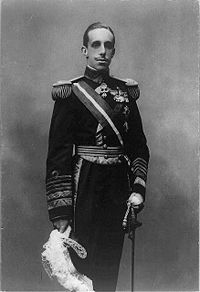 |
Alfonso XIII Alfonso XIII of Spain Alfonso XIII was King of Spain from 1886 until 1931. His mother, Maria Christina of Austria, was appointed regent during his minority... |
Alfonso XIII | May 17, 1886 | April 14, 1931 | Constitutional King of Spain | Son of Alfonso XII Alfonso XII of Spain Alfonso XII was king of Spain, reigning from 1874 to 1885, after a coup d'état restored the monarchy and ended the ephemeral First Spanish Republic.-Early life and paternity:Alfonso was the son of Queen Isabella II of Spain, and... |
|
Second Spanish RepublicSecond Spanish RepublicThe Second Spanish Republic was the government of Spain between April 14 1931, and its destruction by a military rebellion, led by General Francisco Franco....
(1931–1939)
The Second Spanish Republic was the system of government in Spain between April 14, 1931 when King Alfonso XIIIAlfonso XIII of Spain
Alfonso XIII was King of Spain from 1886 until 1931. His mother, Maria Christina of Austria, was appointed regent during his minority...
left the country following a period of social unrest after the collapse of General Primo de Rivera
Miguel Primo de Rivera
Miguel Primo de Rivera y Orbaneja, 2nd Marquis of Estella, 22nd Count of Sobremonte, Knight of Calatrava was a Spanish dictator, aristocrat, and a military official who was appointed Prime Minister by the King and who for seven years was a dictator, ending the turno system of alternating...
's dictatorship a year earlier, and April 1, 1939 when the last of the Republican (republicanos) forces surrendered to Nationalist (nacionales) forces led by Francisco Franco
Francisco Franco
Francisco Franco y Bahamonde was a Spanish general, dictator and head of state of Spain from October 1936 , and de facto regent of the nominally restored Kingdom of Spain from 1947 until his death in November, 1975...
, at the end of the Spanish Civil War
Spanish Civil War
The Spanish Civil WarAlso known as The Crusade among Nationalists, the Fourth Carlist War among Carlists, and The Rebellion or Uprising among Republicans. was a major conflict fought in Spain from 17 July 1936 to 1 April 1939...
.
Presidents of the Republic
| # | Picture | Coat of arms | Name | President From | President Until | Political Party |
|---|---|---|---|---|---|---|
| 1 |  |
Niceto Alcalá-Zamora Niceto Alcalá-Zamora Niceto Alcalá-Zamora y Torres was a Spanish lawyer and politician who served, briefly, as the first premier minister of the Second Spanish Republic, and then — from 1931 to 1936—as its president.... |
December 11, 1931 | April 7, 1936 | Conservative Republican | |
| 2 |  |
Manuel Azaña Manuel Azaña Manuel Azaña Díaz was a Spanish politician. He was the first Prime Minister of the Second Spanish Republic , and later served again as Prime Minister , and then as the second and last President of the Republic . The Spanish Civil War broke out while he was President... |
May 11, 1936 | March 3, 1939 | Republican Left Republican Left (Spain) The Republican Left was a Spanish left-wing republican party founded in 1934.The party was founded in 1934 following the left's defeat in the 1933 election, by the merger of Manuel Azaña's Republican Action, part of Marcelino Domingo's Radical Socialist Republican Party and Santiago Casares... Popular Front Popular Front (Spain) The Popular Front in Spain's Second Republic was an electoral coalition and pact signed in January 1936 by various left-wing political organisations, instigated by Manuel Azaña for the purpose of contesting that year's election.... coalition |
|
Francoist Spain (1936–1975)
On October 1, 1936 General Francisco FrancoFrancisco Franco
Francisco Franco y Bahamonde was a Spanish general, dictator and head of state of Spain from October 1936 , and de facto regent of the nominally restored Kingdom of Spain from 1947 until his death in November, 1975...
was proclaimed Head of State (Caudillo) in parts of Spain controlled by Nationalist (nacionales) forces after Spanish Civil War
Spanish Civil War
The Spanish Civil WarAlso known as The Crusade among Nationalists, the Fourth Carlist War among Carlists, and The Rebellion or Uprising among Republicans. was a major conflict fought in Spain from 17 July 1936 to 1 April 1939...
broke out. After the end of war on April 1, 1939 General Franco took control of entire Spain. In 1947, Franco proclaimed the restoration of the monarchy, but did not allow the pretender, Juan de Borbón, Count of Barcelona, to take the throne. In 1969, Franco declared that Juan Carlos, the Count of Barcelona's son, would be his successor. After Franco's death in 1975, Juan Carlos succeeded him as the King of Spain.
Head of State (Caudillo)
| # | Picture | Coat of arms | Name | Head of State From | Head of State Until | Political Party |
|---|---|---|---|---|---|---|
| 1 | 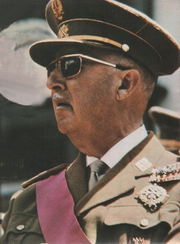 |
Francisco Franco Francisco Franco Francisco Franco y Bahamonde was a Spanish general, dictator and head of state of Spain from October 1936 , and de facto regent of the nominally restored Kingdom of Spain from 1947 until his death in November, 1975... |
October 1, 1936 | November 20, 1975 | Traditionalist Spanish Falange and of the Unions of the National-Syndicalist Offensive (FET-JONS) Military |
|
House of BourbonHouse of BourbonThe House of Bourbon is a European royal house, a branch of the Capetian dynasty . Bourbon kings first ruled Navarre and France in the 16th century. By the 18th century, members of the Bourbon dynasty also held thrones in Spain, Naples, Sicily, and Parma...
(third restoration)
Alfonso XIII's claim descended (due to his two eldest sons' renunciations) to his third son, Infante Juan, Count of Barcelona, who was passed over in favour of his eldest son, whose title is King of Spain. The Count of Barcelona renounced his claims in favour of his son in 1977, two years after Franco's death and Juan Carlos's accession.| # | Picture | Coat of arms Coat of arms of the King of Spain The blazoning of the coat of arms of the King of Spain is set out in Title II, Rule 1, of Spanish Royal Decree 1511 of 21 January 1977, by which the Rules for Flags, Standards, Guidons, Banners, and Badges were adopted.- Quartered shield :... |
Name | Spanish Name | Monarch From | Monarch Until | Titles Used | Relationship with predecessor(s) |
|---|---|---|---|---|---|---|---|---|
| 18 | 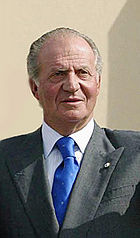 |
Juan Carlos I of Spain Juan Carlos I |Italy]]) is the reigning King of Spain.On 22 November 1975, two days after the death of General Francisco Franco, Juan Carlos was designated king according to the law of succession promulgated by Franco. Spain had no monarch for 38 years in 1969 when Franco named Juan Carlos as the... |
|
November 22, 1975 | Incumbent Incumbent The incumbent, in politics, is the existing holder of a political office. This term is usually used in reference to elections, in which races can often be defined as being between an incumbent and non-incumbent. For example, in the 2004 United States presidential election, George W... |
King of Spain | Grandson of Alfonso XIII, through his third son, Infante Juan, Count of Barcelona | |
See also
- Spanish monarchySpanish monarchyThe Monarchy of Spain, constitutionally referred to as The Crown and commonly referred to as the Spanish monarchy or Hispanic Monarchy, is a constitutional institution and an historic office of Spain...
- Kings of Spain family treeKings of Spain family treeThis is a collection of the family trees of the kingdom of Spain. The former kingdoms of Aragon, Castile and Navarre were independent kingdoms that unified in the 15th century to become the Kingdom of Spain....
- Line of Succession to the Spanish Throne
- Royal Consorts of SpainRoyal Consorts of Spain- House of Habsburg :- House of Bourbon :- House of Bonaparte :- House of Bourbon :- House of Savoy :- House of Bourbon :-See also:*List of Spanish monarchs*List of Aragonese consorts...
- War of the Spanish SuccessionWar of the Spanish SuccessionThe War of the Spanish Succession was fought among several European powers, including a divided Spain, over the possible unification of the Kingdoms of Spain and France under one Bourbon monarch. As France and Spain were among the most powerful states of Europe, such a unification would have...
- President of SpainPresident of SpainToday, Spain is a constitutional monarchy. King Juan Carlos I, the current monarch, is Head of State. The Head of Government has the official title of President of the Government....
- Prime Minister of SpainPrime Minister of SpainThe President of the Government of Spain , sometimes known in English as the Prime Minister of Spain, is the head of Government of Spain. The current office is established under the Constitution of 1978...
- List of Spanish monarchs
- Carlist pretenders have tried to substitute the Isabelline monarchs.

